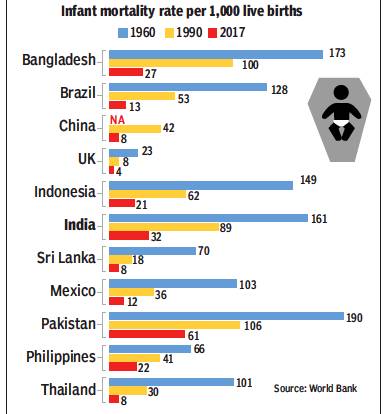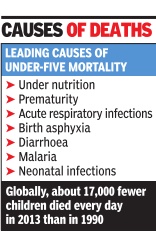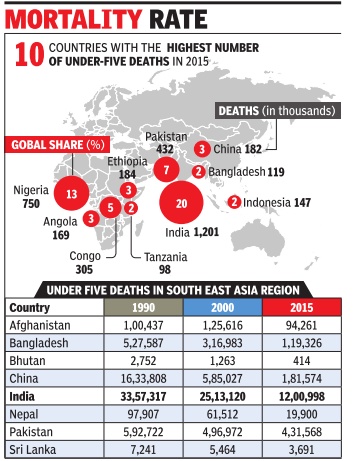Infant mortality: South Asia
This is a collection of articles archived for the excellence of their content. Readers will be able to edit existing articles and post new articles directly |
1960-2017: South Asia, major developing countries

From: August 27, 2019: The Times of India
See graphic:
Infant mortality rate per 1,000 live births, in India, Bangladesh, Brazil, China, Indonesia, Mexico, Pakistan and the UK, 1960- 2017
Across the world, babies more likely to survive now
In the 1960s, every fifth child in developing countries died within a year of birth. Since then, the infant mortality rate (IMR) has fallen sharply, thanks to better sanitation, availability of clean drinking water and immunisation, delayed motherhood and better maternal health. However, the developing world still has a higher IMR than the industrialised countries did in the 1960s.
1990-2017: India, China do well; Bangladesh excels
August 31, 2019: The Times of India

1990, 2017,
in India, Bangladesh, Brazil, China and Ethiopia.
From: August 31, 2019: The Times of India
Child deaths reduced by 60% in past 30 years
12.6 million children aged below 5 years died of various diseases in 1990. With improved healthcare, the number fell to 5.4 million in 2017. In many countries, fewer than 1 in 500 children now dies before turning 5. Although India’s infant mortality rate has fallen by 70%, every 100th child still dies here.
2012: India tops global list of 1st-day deaths of infants
Jayashree Nandi 2013/05/07
More newborns die on the first day in India than in any other country, according to the latest ‘State Of The World’s Mothers ’ report. Every year, over 3,09,300 children (29% of the global share) in India don’t live beyond the first day because of complications associated with preterm birth, hygiene and maternal health, the report says.
The report by the United States-based Save the Children, which ranks 176 countries on maternal and child mortality, will release globally on Tuesday.
Despite being more populated, China ranks 4th and accounts for only 5% of the global share of first-day deaths. Nearly two-thirds of all first-day deaths occur in just 10 countries and most of these countries have very large populations like India and Indonesia.
Others high up on the list are Pakistan, Afghanistan and African nations like Nigeria and Ethiopia. Predictably, just 1% of the global first-day deaths occur in developed countries.
South Asia is particularly vulnerable because the region has only 14 doctors or nurses per 10,000 people, the report says. Other reasons include preterm deliveries, low birth weight (28% of babies in India are underweight) and stunting among women. Stunting refers to a height of less than 4ft 7. Early marriage and childbearing heightens the risk for babies further. In India 47% girls are married off by the age of 18.
India also fares very poorly in maternal health, with 56,000 maternal deaths per year. Pakistan, with 12,000 maternal deaths, is ranked right above India. Overall, India ranks 142 among 176 countries.
South Asia is particularly vulnerable because the region has only 14 doctors or nurses per 10,000 people according to the report. Other reasons include pre-term deliveries, low birth weight (28% of babies in India are underweight) and stunting among women. Stunting refers to a height of less than 145 cm. The report says that in Bangladesh, India and Nepal close to 13% of women are stunted and at a higher risk for complications of having smaller babies. In these countries, 20% to 40% of women are also very thin. Early marriage and childbearing heightens the risk for babies further. In India 47% girls marry by the age of 18, in Bangladesh child marriage and early childbearing is most prevalent with 66 % of young women getting married and 40% giving birth by before 18 years.
Dr Rajiv Tandon, senior adviser for health and nutrition at Save the Children, feels that India suffers from systemic problems. "We don't just lack resources but also training of frontline workers, supportive supervision and data for decision making. We need to find out whether our auxiliary nurse midwife (ANMs), Accredited Social Health Activist (ASHA) workers and anganwadi workers are motivated? In most districts they lack the supplies required and don't have the skill-sets to deal with such emergency situations," he says.
Tandon also points to cultural issues that most often risk the lives of both baby and mother. "In rural areas there is a culture of applying absolutely anything to the umbilical chord, from cow dung to oils. This can cause acute local infection and even neonatal sepsis. Another such misunderstanding is that in many parts of India people think that colostrum (first breast milk rich in anti-bodies) is not suitable for feeding. These have tremendous effect on the morbidity of newborns," he adds.
The report recommends using simple and effective techniques by frontline workers like when a mother is in preterm labor the attendant can administer an injection of corticosteroids to accelerate lung development of the fetus while the baby is still in the womb. Or, for birth asphyxia when babies don't breathe after birth (kills about 717,000 babies each year), the practice of drying the baby and gently rubbing to stimulate breathing can prevent death.
India is faring very poorly even in maternal health with 56,000 maternal deaths per year followed by Pakistan which has 12,000 maternal deaths per years. India ranks 142 among 176 countries where the first rank goes to Finland and the last rank to Democratic Republic of the Congo for maternal health and well-being. The index for this ranking was developed on the basis of five indicators—maternal health, children's wellbeing, educational status, economic status and political status of women in their country.
1990-2013: Under-5 mortality

May 18 2015
WHO: Under-5 mortality down 50% since 1990
Sushmi Dey
Almost half the child deaths worldwide are still caused due to under-nutrition despite substantial progress made to reduce under-five mortality , a new report by the World Health Organization (WHO) secretariat has said. Between 1990 and 2013, under-five mortality declined by 49%, falling from an estimated rate of 90 deaths per 1,000 live births to 46 deaths per 1,000 live births.The global rate of decline has also accelerated significantly, from 1.2% per annum between 1990 and 1995 to 4% per annum between 2005 and 2013. About 17,000 fewer children died every day in 2013 than in 1990.
“Despite the evidence of progress, the gains remain insufficient to reach the target of a two-thirds reduction from 1990 levels of mortality by the year 2015,“ the report, which will be released during the 68th World Health Assembly to be held from May 18 to 27 in Geneva, said.
The report also pointed to at the slower decline in neonatal mortality rate and its increasing proportion in total under-five deaths. In 1990, neonatal deaths accounted for 37% of the total under-five children deaths, and the share increased to 44% in 2013.
The observations are significant with 22% of the total under-five deaths occurring in India. Estimates show that in 2013, over 15 lakh underfive children died in India.
Child mortality is also high in Nigeria, Democratic Republic of the Congo, Pakistan and China.
However, the report observed India's efforts to control deaths due to diarrhoea and pneumonia, which contribute almost 24% of the total under-five deaths.
The annual Health Assembly , a supreme decisionmaking body of WHO, will be attended by delegations from 194 WHO member countries, who will review activities of WHO through the year and set priorities for the future.This year, India has assumed presidency at the global event after a gap of 19 years.
The report, titled `Monitoring of the achievement of the health-related Millennium Development Goals', lists other issues such as maternal mortality , people suffering from hunger, reproductive health as well as spread of HIV.
2015: Under-5 mortality
The Times of India, Sep 09 2015

Kounteya Sinha
20% of world's under-5 deaths occur in India
Rate down 62% since '90; Pneumonia main killer
One in every 21 chil dren born in India is dying be fore the age of five, and one in every five under-five deaths in the world is an Indian's. Latest data to be publish ed soon in British journa `The Lancet' reveals that In dia has recorded the highest number of under-five deaths in the world so far this year India's under-five mortality rate (U5MR) for 2015 is about seven times higher than in some high-income countries where 1 in 147 children died before their fifth birthday .
There is some good news too, however. India's U5MR has dropped 62% since 1990 from 126 deaths per 1,000 live births to 48. This is higher than the average global reduction of 53%.
Infectious diseases such as pneumonia and diarrhoea remain the main killers of Indian children aged below five years. In 2015, pneumonia accounted for an estimated 15% of the 12 lakh under-five deaths in India. Diarrhoea accounted for about 9%.
The results are part of a study by the Unicef-led Interagency Group for Child Mortality Estimation (UN IGME).It has been noted in the study that although there has been substantial progress globally , only 62 of 195 countries have managed to meet the Millenni um Development Goals (MDG, which include reducing child mortality) target of curbing U5MR by two-thirds between the 1990-2015 target period.
Led by Dr Danzhen You of UNIGME, the research pegs the number of under-five deaths between 1990 and 2015 at a whopping 236.3 million around the world. Speaking to TOI, Dr You said, “Given the large under-five population and its relatively high mortality rate, India has the largest number of under-five deaths in the world. Progress in India will therefore greatly affect the average progress in its region and in the world.“
2016: Myanmar, India the worst
Sushmi Dey, India fails to protect its U-5 kids, March 7, 2017: The Times of India

`Pollution, Poor Sanitation Lead To High Death Rate'
India accounts for the second highest death rate of children under 5 years due to environmental risks -mainly pollution and poor sanitation -in the WHO south east Asia region which includes Bangladesh, Indonesia and Bhutan. In fact, India fares far worse than China and is among the top 35 countries in the world with highest death rate among under-5 years children attributable to unhealthy environment.
While India recorded 248.14 deaths among children under-5 years of age per lakh people, Myanmar -also part of the WHO's south east Asia region -reported over 297 deaths per lakh annually , new assessments by the UN agency shows.
Globally, more than 1 in 4 deaths of children under 5 years of age are attributable to unhealthy environments. Every year, envi ronmental risks -such as indoor and outdoor air pollution, secondhand smoke, unsafe water, lack of sanitation, and inadequate hygiene -take the lives of 1.7 million children under 5 years, claim two new WHO reports.
Highlighting the need for improved sanitation in India to save children, the report said 44% of India's population defecate and urinate in open spaces, leading to greater risk of infectious diseases like diarrhoea and acute respiratory infection along with malnutrition.Lack of menstrual hygiene is also seen as a major cause of infection among young girls and mothers.
“National behaviour change handwashing programmes in India and China would produce large economic gains from reduced diarrhoea and acute respiratory infections such as a 92-fold return to investment in India and a 35-fold return to investment in China,“ one of the reports said.
The report also pointed at health risks from polluted drinking water, mainly presence of arsenic, which occurs naturally in ground water and causes serious risks to children's health.
2017: Pakistan, Afghanistan, India 1,3, 12 from bottom; SL betters USA

From: DurgeshNandan Jha, Newborn mortality: India 12th worst among low-income countries, February 20, 2018: The Times of India
India has been ranked 12th -worst among 52 low-middle income countries based on the number of children dying within the first month of their birth, which is 25.4 per 1,000 live births.
Pakistan is the worst with 45.6 newborn deaths per 1,000 live births, according to the United Nations Children’s Fund (Unicef) which has, for the first time, come out with rankings based on their newborn mortality rate (the number of deaths per 1,000 live births).
Japan, with an NMR of 0.9 deaths per 1,000 live births, has been ranked the world’s safest country in which to be born followed by Iceland (1) and Singapore (1.1). The US’s NMR stands at 3.7, only slightly better than lower-middle income countries like Sri Lanka and Ukraine, and is ranked 15 among high-income countries.
Unicef says newborn survival is closely linked to a country’s income level. “High-income countries have an average NMR of just 3. In comparison, lowincome countries have an NMR of 27. This gap is significant. If every country brought its NMR to the high-income average, or below, by 2030, 16 million newborn lives could be saved,” the UN body says.
It adds that more than 80% of newborn deaths are the result of premature birth, complications during labour and delivery and infections such as sepsis, meningitis and pneumonia. “Babies born to mothers with no education face almost twice the risk of dying during the newborn period as compared to babies born to mothers with at least secondary education,” said an official.
2017: India, Pakistan have highest, 3rd highest number
3 infants die every 2 minutes in India, says UN report, September 19, 2018: The Times of India
Three infants die every two minutes on an average in India due to lack of access to water, sanitation, proper nutrition or basic health services, according to a report by the United Nations Inter-agency Group for Child Mortality Estimation (UNIGME).
About 8,02,000 infant deaths were reported in India in 2017, the lowest in five years, but the infant death numbers still remained the highest in the world, according to the report.
Dr Gagan Gupta, chief of health at the WHO, however, said India is making good progress in combatting reasons leading to infant deaths through a number of government-led initiatives.
“It has to be taken into consideration that India has a birth rate of 25 million every year and the number of infant deaths have come down and is lowest in five years. This is also the first time that the number of deaths under five is equal to number of births. The next step would be reducing the number of deaths,” he said.
The main reasons behind infant deaths remain to be lack of access to water, sanitation, proper nutrition or basic health services, Gupta said. Infant deaths were reported highest in the world in India, followed by Nigeria at 4,66,000 and Pakistan at 3,30,000 the report said.
See also
Infant mortality: South Asia